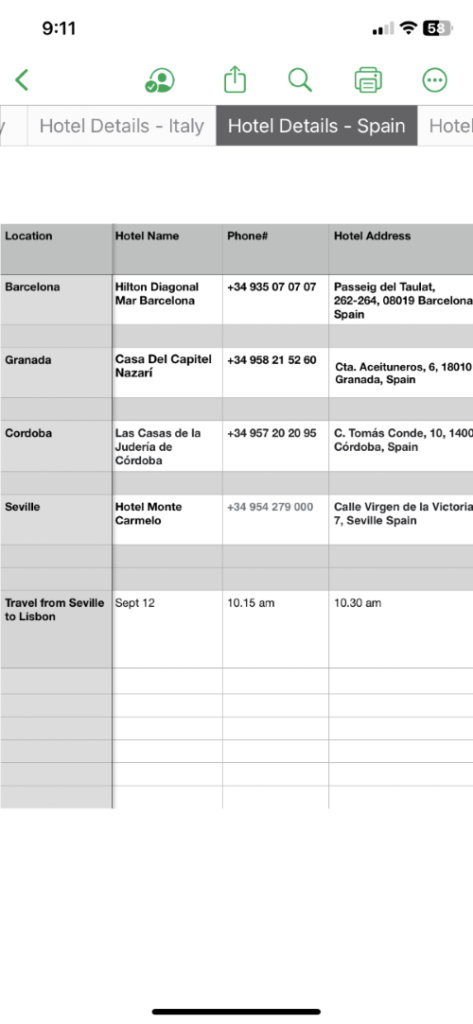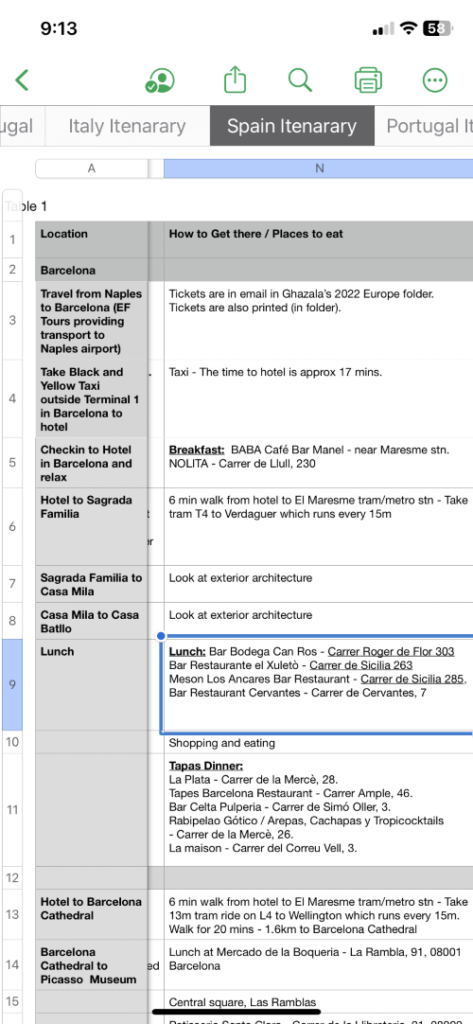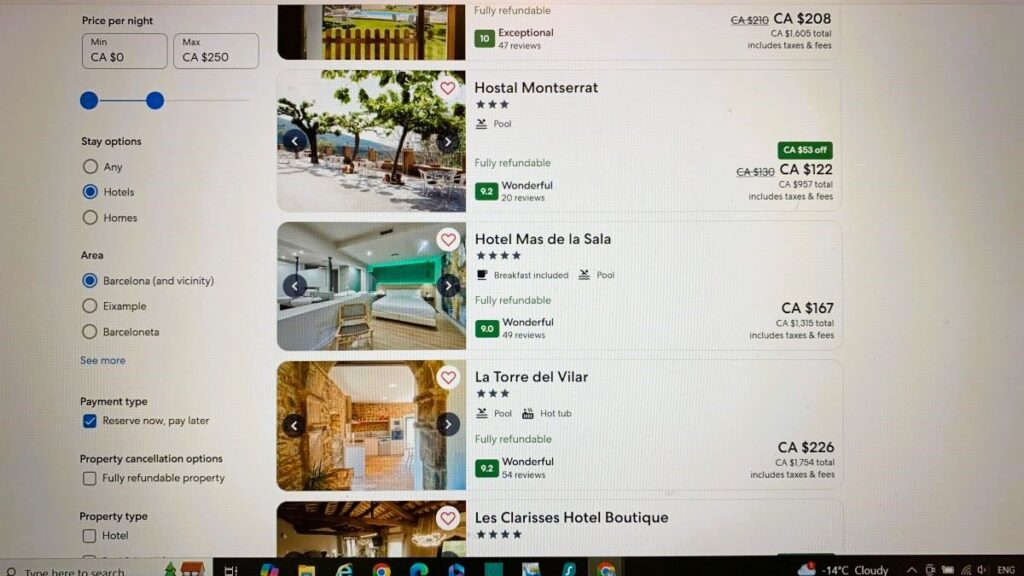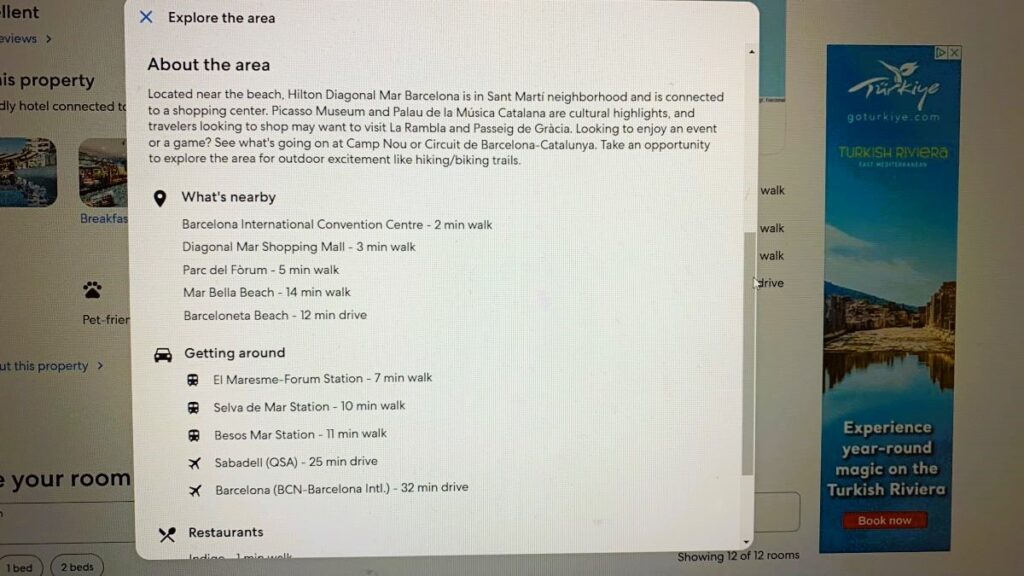Are you planning an overseas trip, and feeling overwhelmed? Not sure where to start? I know the feeling!
My wife and I have done a lot of overseas traveling in the last 3 or 4 years – over 40 countries so far – and I know how much work has to go into planning for these trips. (To learn more about us click here).
Planning for an overseas trip is exciting, but it can also feel overwhelming, especially if it’s a multi-city/multi-country trip.
So how to plan an overseas trip when there are so many details to think about? You have to deal with flights, accommodations, currencies and exchange rates, visa requirements, languages, and so much more.
In this international multi-city trip planning guide, I’ll share some trip planning tips that I’ve put together based on our own personal experience.
We’ve made mistakes, and we’re also learning with each trip. It’s never simple, especially if you’re planning to visit several cities or countries in your trip.
We usually try to visit 2 or more countries on each of our trips – ones that are situated closer to each other geographically. Our latest trip was to the Balkans in May/June of 2025. We visited Serbia, Slovenia, Bosnia & Herzegovina, Macedonia, and Bulgaria. Amazing countries, all of them!
Hopefully this guide will be helpful as I’ll walk you through the entire process from booking flights to accommodation and staying connected, so you can focus on enjoying the adventure ahead.
As you’re reading this you probably already have a place, or places, in mind that you want to visit. Make sure you know what the weather is going to be, and pack accordingly.
My wife is great with spreadsheets. We use spreadsheets to keep everything well organized. You can put down as much or as little detail as you want.


1. Researching and Booking Flights
Once you have decided where you want to go, and for how long, you can move to the next step which is researching and booking flights. If you are flexible with your dates then it becomes a bit easier.
Your flight sets the foundation for your trip, so finding affordable and convenient flights is often the first step in planning an overseas trip.
Start Early
- Begin your search 3-6 months in advance for the best deals. Airlines often release their cheapest tickets during this window.
- Use flight comparison websites like Expedia, Skyscanner, Google Flights, or Kayak to explore options. (to understand which is better you can check this website). We use Expedia a lot. We’re happy with it.
If your plan is to visit more than 1 country or city, then look for flights (or sometimes trains or buses) from one place to another. If you’re traveling to Europe, Eurail is a great option. Even on our last trip to Uzbekistan we traveled by train from one city to another.
The trick is to get the flights (or other means of transportation as the case may be) all in order. If you’re flying everywhere then Expedia will work great.
Set Alerts
- Most flight search engines let you set price alerts. This feature notifies you when ticket prices drop, helping you book at the right time.
Be Flexible with Dates and Airports
- Flying midweek or during off-peak seasons often costs less.
- Consider alternate airports near your destination, which might offer cheaper options.
Look for Layovers
- Nonstop flights are convenient but often more expensive. Opting for layovers can save money, though it adds travel time. Longer layovers can be cheaper. Turn a layover into an opportunity to explore a second city.
Pro Tip:
If you’re visiting multiple countries, search for “multi-city” flight options. For example, fly into Barcelona and out of Lisbon, avoiding the need to backtrack.
2. Plan Your Itineraries For Places You Will Be Visiting
- Look for top attractions, natural landmarks, historical sites, or cultural experiences. Use travel blogs, guidebooks, or apps like Google Travel, TripAdvisor, or AllTrails.
- Create a list of places and activities you absolutely want to experience.
We love to take walking tours. There are many walking tour companies. Our go to is Guru Walking Tour. It’s a free walking tour. They work on tips which you pay at the end of the tour. I believe they operate in most countries around the world. You need to book your date and time in advance online. You can download their app.
3. Choose the Perfect Accommodation
Next is the accommodation. Your choice of accommodation depends on your travel style, budget, and destination.
Research Neighborhoods
- In our own research we’ve used travel blogs, YouTube videos, platforms like Google Maps or TripAdvisor to learn about neighborhoods.
- Look for areas close to attractions or public transportation to save you time and money. We’ve always looked for hotels that are within walking distance from a metro station or bus stop. Also check to see which areas are safe for tourists, and which areas to avoid. This is very important!
- Look for reviews. 9 star or over are great! Sometimes you may have to settle for high 8s.
Compare Options
- Websites like Expedia, Booking.com, Airbnb, and Hotels.com let you filter by price, amenities, neighborhoods and reviews. Again, we use Expedia mostly. We always got good service from them.
- For budget-friendly stays, consider hostels or guesthouses.


Book Early
- Popular hotels can fill up fast, especially in peak seasons. Secure your accommodation as soon as your travel dates are confirmed.
Consider Local Experiences
- Unique stays, like a riad in Morocco or a ryokan in Japan, can enhance your cultural experience.
Pro Tip:
Check cancellation policies. Many hotels also offer “book now pay later” flexibility. Plans can change, and flexible booking options can save you money. If breakfast is included that’s even better.
4. Creating a Realistic Travel Budget
In our case we had decided that we would travel 3 times a year. We are retired and this is what we planned for. We also have an idea of the budget for each trip. This way we know how much we’re going to be spending on each trip, and it helps to stay within the budget.
Depending on where we go we can adjust the number of weeks to fit the budget. On an average we are gone for 6 to 7 weeks at a time.
Budgeting ensures you don’t overspend and lets you enjoy your trip stress-free. Divide your budget into the following categories:
Flights
- Typically, flights are the largest expense. Use the tips above to keep costs down.
Accommodations
- Research average nightly rates for your destination. Hostels and budget hotels are great for saving money.
Meals
- Decide how often you’ll eat out versus grabbing snacks or cooking. For instance, street food in Southeast Asia is delicious and inexpensive, while dining out in Switzerland can be pricey. If your hotel includes breakfast, then you can have a hearty breakfast and get by on a light snack for lunch.
- Research affordable local eateries on the internet. Google Maps or Yelp are good resources.
- Look for fixed-price lunch menus or street food to save money.
Sightseeing
- Many attractions have entrance fees, so research costs in advance. Look for city passes that bundle multiple attractions for a discount.
- Prioritize free or discounted attractions. Many museums offer free entry on specific days.
- Pre-book popular attractions to save time and avoid long queues.
Transportation
- Factor in local transit, taxis, or car rentals. Apps like Rome2Rio can help estimate costs.
Emergency Fund
- Always set aside extra funds for unexpected expenses, such as medical emergencies or last-minute changes.
What we do: Once we have an idea of how much money we’re going to need, we buy the required currency from our bank in Canada. In most countries you can use credit cards, but sometimes you need cash, for example shopping in markets (like the night markets in Thailand), or street food and tipping, etc. So it’s a good idea to take some cash with you.
Pro Tip: Track expenses using apps like Trail Wallet or TravelSpend.
5. Choosing the Best Times to Visit Different Destinations
Timing your trip right can enhance your experience and save you money:
High Season vs. Low Season
- High season offers the best weather but comes with crowds and higher prices.
- Low season is budget-friendly and less crowded but may bring less favorable weather.
Shoulder Season
- The sweet spot between high and low season offers decent weather, smaller crowds, and moderate prices. For instance:
- Europe: April-May or September-October
- Southeast Asia: November-February
- South America: March-May or September-November
Weather Considerations
- Research the climate of your destination. For example, avoid monsoon season in Thailand or winter in Canada if you’re not prepared for extreme conditions.
6. Understanding SIM Card and eSIM Options for Communication Abroad
Staying connected is essential, whether for navigation, emergencies, or staying in touch with loved ones.
SIM Cards
- Purchase a local SIM card upon arrival for affordable data and calls.
- Ensure your phone is unlocked to accept foreign SIM cards.
- Example: In Europe, consider Orange Holiday SIM, which works across multiple countries.
eSIM Options
- If your phone supports eSIM, you can download a plan before you travel. Providers like Airalo offers global and regional eSIM options.
- eSIMs save you the hassle of swapping physical cards.
Pro Tip: Download messaging apps like WhatsApp to stay connected using Wi-Fi, reducing reliance on cellular data.
7. Download Helpful Apps
Technology can simplify your trip:
Translation Apps
- Google Translate: Offers real-time text translation and a camera feature to translate signs or menus. This is a game changer! We’ve used it everywhere – Japan, Korea, Taiwan, Uzbekistan and many more countries. You can read menus in restaurants, communicate with people, and read labels on anything that you buy, especially if you need to buy any kind of medication.

Travel Organization Apps
- TripIt: Automatically organizes your bookings and itineraries in one place.
- PackPoint: Creates a packing list based on your destination, weather, and activities.
Navigation Apps
- Google Maps: Best for navigating cities and public transport.
- Maps.me: Allows offline navigation, ideal for remote areas.
Currency Conversion
- XE Currency for real-time exchange rates.
Emergency Info
- Red Cross First Aid app for basic health advice.
Pro Tip: Save important travel details offline, such as reservation numbers and contact info.
8. Plan Your Packing for Trips
Packing smartly can save you time, money, and stress while traveling. Here’s how to plan your packing:
Check the Weather
- Research the climate of your destination to pack appropriately. For example, layers are essential for Europe in spring, while lightweight clothes are better for tropical destinations.
Pack Light
- Stick to the essentials. A carry-on is often sufficient for shorter trips and avoids checked baggage fees. We usually travel with just the carry-on (except in places where my wife plans to shop). It’s less headache, and no chance of losing your bags. You will end up doing laundry once in a while. There are usually coin operated laundromats almost everywhere. Google before hand to make sure. Or the hotel may have laundry facility.
- Use packing cubes to organize and maximize space.
Essentials Checklist
- Documents: Passport, visa, travel insurance, and printed copies of bookings. Make copies of your passport, just in case.
- Clothing: Pack versatile items you can mix and match. Include comfortable walking shoes.
- Toiletries: Bring travel-sized products, or plan to buy locally.
- Electronics: Phone, charger, power bank, and universal adapter.
- Medicine: Any prescribed medication, along with a small first-aid kit.
Pack for Cultural Sensitivity
- Research cultural norms regarding attire. For instance, covering your shoulders and knees is respectful in many religious sites.
Pro Tip: Roll your clothes instead of folding them to save space and reduce wrinkles.
9. Additional Tips and Resources for a Smooth Travel Experience
Get Travel Insurance
- Protect yourself against unexpected events like trip cancellations or medical emergencies. Providers like World Nomads or Allianz Travel offer comprehensive coverage. Check to see if your credit card provides coverage.
Check Visa Requirements
- Some countries require visas, which can take time to process. Visit official government websites to confirm requirements.
Understand Currency Exchange
- Use your bank card for better rates, but notify your bank of international travel to avoid transaction blocks.
- We normally buy the currency through our bank in Canada before we leave. It’s always a good idea to have some cash on you when you arrive at your destination. Keep it in small denominations – you may need it for taxis, tips, street food, etc.
- Apps like XE Currency help track exchange rates.
Pack Smart
- Pack light and consider the weather at your destination. Use packing cubes to stay organized.
Stay Safe
- Share your itinerary with a friend or family member.
- Research local safety tips, such as avoiding specific neighborhoods or respecting cultural norms.
10. What You Need to Take Care of Before You Leave
1. Manage Your Mail and Deliveries
- Hold Your Mail: Request a mail hold through your local post office (e.g., Canada Post). Most postal services offer this online.
- Pause Newspaper Deliveries: If you happen to have any newspaper subscriptions, suspend those to avoid piled-up papers signaling your absence.
- Inform Neighbors: Ask a trusted neighbor to pick up unexpected deliveries, flyers or keep an eye out.
2. Secure Your Home
- Notify Security Service: Inform your alarm company (if applicable) that you’ll be away and confirm your contact information.
- Set Timers for Lights: Use smart plugs or timers for lights to mimic your usual routines and deter burglars.
- Check Outdoor Security Cameras: Ensure your cameras are functional and have adequate storage or cloud access.
- Hide Spare Keys: Remove any hidden keys from obvious spots like under mats or flowerpots.
- Lock All Doors and Windows: Double-check that every entry point is securely locked.
3. Manage Utilities
- Turn Off the Water Main: Shut off the main water supply to prevent leaks or floods. Flush the toilets and open the taps to make sure all the water has drained from the pipes.
- Lower the Thermostat: Set the thermostat to an energy-saving mode. In winter, don’t set it below 55°F (13°C) to avoid frozen pipes.
- Unplug Electronics: Disconnect unnecessary appliances (TVs, toasters, etc.) to reduce power consumption and protect against power surges.
- Check the Water Heater: Turn it to “vacation mode” or lower the temperature to save energy.
4. Prepare for Emergencies
- Designate a Contact Person: Share your travel itinerary and home keys with a trusted friend or neighbor who can act in an emergency.
- Test Smoke and Carbon Monoxide Detectors: Ensure these devices are functioning properly.
- Inspect Sump Pump: If you have one, confirm it’s working to avoid basement flooding.
5. Handle Food and Trash
- Clean Out the Fridge: Discard perishable items to prevent odors.
- Take Out the Trash: Empty all garbage bins to avoid attracting pests. If there’s a trash pick up day after you leave, you can ask a neighbor to put out the bins for you.
- Run the Garbage Disposal: Flush it with water and lemon to prevent odors.
6. Yard and Outdoor Maintenance
- Trim Lawn and Bushes: Keep up with landscaping to avoid signaling your absence.
- Secure Outdoor Furniture: Protect outdoor items from storms or theft.
- Arrange for Snow Removal: If traveling in winter, ensure driveways and walkways are cleared.
7. Other Key Tasks
- Set Automatic Payments: Ensure bills due during your vacation are scheduled for automatic payment.
- Hold Subscriptions: Pause subscription boxes or similar deliveries.
- Pack Essentials: Don’t forget chargers, travel documents, and medication.
By preparing in advance, you’ll reduce the chances of returning to unwelcome surprises and can enjoy your trip with fewer worries.
Final Thoughts
Planning for international travel may seem daunting, but breaking it into steps makes the process manageable. By researching thoroughly, budgeting wisely, and packing smartly, you’ll be well-prepared to make unforgettable memories.
Bon voyage! 🌍

